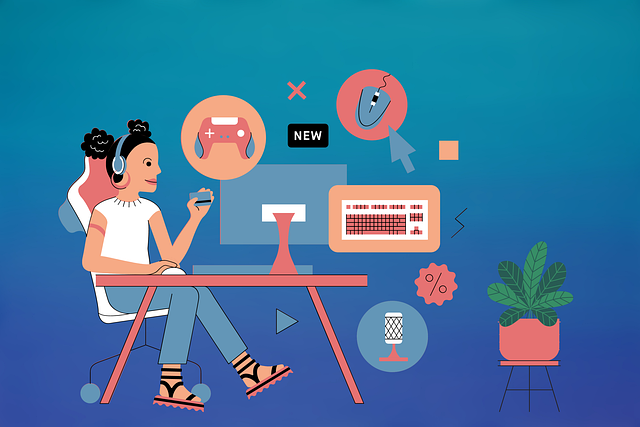Online therapy platforms are transforming mental healthcare by offering accessible art therapy sessions globally, breaking down geographical barriers and providing a flexible, convenient, and often more affordable alternative to traditional in-person services. These platforms utilize video conferencing, digital art tools, secure messaging, and multimedia sharing to foster self-expression and emotional healing for diverse populations, including those in remote areas or with limited mobility. With robust security measures, tailored communication strategies, and proactive technical troubleshooting, online therapy platforms ensure effective and inclusive therapeutic experiences. The future of art therapy looks digital, incorporating VR and AI for enhanced accessibility, affordability, and effectiveness.
The digital age has given rise to a new therapeutic frontier: web-based art therapy sessions. As mental health care increasingly shifts online, online therapy platforms play a pivotal role in making treatment more accessible. This article explores the benefits and challenges of conducting art therapy virtually, from setting up safe, interactive digital spaces to engaging clients remotely. We delve into the latest tools, privacy measures, and technological advancements shaping this evolving field.
The Rise of Digital Art Therapy: A New Frontier in Mental Health Care

In recent years, the field of mental health care has witnessed a significant shift with the advent of digital art therapy sessions delivered through online therapy platforms. This innovative approach to art therapy has opened up new possibilities for individuals seeking support from the comfort of their homes. The rise of remote art therapy is particularly notable in today’s digital era, where technology has seamlessly integrated into our daily lives. With the help of video conferencing tools and user-friendly interfaces, clients can now engage in creative processes with trained therapists without geographical barriers.
The popularity of online therapy platforms underscores a growing need for accessible mental health services. Art therapy, known for its ability to foster self-expression and emotional healing, has found a new frontier in the digital space. This shift not only expands the reach of art therapy but also promotes inclusivity, making therapeutic support more readily available to diverse populations, including those in remote areas or with limited mobility.
Online Therapy Platforms: A Gateway to Accessible Treatment

In today’s digital era, the rise of online therapy platforms has opened doors to accessible art therapy sessions for individuals worldwide. These platforms democratize mental health care by eliminating geographical barriers and providing a convenient, often more affordable alternative to traditional in-person therapy. With a simple internet connection, clients can connect with licensed therapists from the comfort of their homes, ensuring continuity of care regardless of location or mobility issues.
Online therapy platforms offer a range of features tailored to enhance therapeutic experiences. Video conferencing tools enable face-to-face interactions, fostering rapport and trust between therapist and client. Digital art materials, such as online drawing boards and painting applications, serve as creative mediums for expression in remote settings. Additionally, these platforms often incorporate secure messaging systems and multimedia sharing capabilities, allowing therapists to receive visual insights into their clients’ lives and progress, thus facilitating more personalized treatment plans.
Benefits of Web-Based Art Therapy Sessions: Reach and Flexibility

Web-based art therapy sessions offer a unique advantage in terms of reach and flexibility, expanding the accessibility of therapeutic art practices to a broader audience. Unlike traditional in-person therapies, online therapy platforms allow individuals from diverse geographic locations to participate, breaking down physical barriers. This is especially beneficial for those living in remote areas or with limited mobility, ensuring they can access art therapy services without the need for travel.
The flexibility of these sessions is another significant advantage. Participants can schedule appointments at times that suit them best, accommodating busy schedules and promoting a more personalized therapeutic experience. This adaptability also extends to the frequency of sessions, allowing clients to decide on the pace that works best for their well-being journey, whether it’s weekly or bi-weekly meetings.
Setting Up Virtual Spaces: Creating a Therapeutic Environment Online

In the digital age, setting up virtual spaces for art therapy sessions through online therapy platforms has opened new avenues for healing and expression. These platforms provide a secure and accessible environment where clients can connect with therapists from the comfort of their homes. Through video conferencing tools, therapists create a safe haven, establishing boundaries and ensuring confidentiality, just as they would in a physical office. The virtual setup allows for flexibility, accommodating individuals with limited mobility or those in remote areas who may not have access to traditional art therapy services.
Creating an online therapeutic space involves more than just turning on a camera. Therapists carefully design these digital environments to foster creativity and emotional exploration. Backgrounds can be customized to evoke a sense of calm or inspire specific themes, much like a physical studio. The use of shared screens enables therapists to guide clients through art-making processes, providing real-time feedback and encouragement. This innovative approach to art therapy leverages technology to connect individuals with mental health support, making therapeutic practices more inclusive and accessible than ever before.
Interactive Tools for Art Creation: Paints, Brushes, and Digital Canvas

In the realm of web-based art therapy sessions, interactive tools for art creation have evolved significantly, offering a dynamic experience on online therapy platforms. Paints and brushes, traditionally physical, now find their digital counterparts in software that mimic the feel of real media, enabling clients to explore creativity and express themselves without leaving home. These virtual tools provide a vast array of colors, textures, and brush types, fostering an engaging environment for both therapists and clients.
Digital canvas platforms enhance artistic expression by offering features such as layers, erasers, and undo buttons, allowing artists to experiment freely. Many online therapy platforms integrate these digital art tools seamlessly, ensuring accessibility and convenience for remote sessions. This shift towards technology not only broadens the reach of art therapy but also caters to diverse learning styles and preferences, making artistic expression more inclusive and accessible in today’s digital era.
Privacy and Security Measures: Protecting Sensitive Information During Online Sessions

In the realm of web-based art therapy sessions facilitated by online therapy platforms, privacy and security measures are paramount. These digital spaces host sensitive information, including personal details, artistic creations, and therapeutic discussions. Reputable online therapy platforms employ robust encryption protocols and secure data storage methods to safeguard this confidential material from unauthorized access or breaches.
Many of these platforms adhere to stringent industry standards, such as HIPAA (Health Insurance Portability and Accountability Act) in the U.S., ensuring that patient records are handled with the utmost discretion. Additionally, they implement multi-factor authentication, regular security audits, and user privacy policies to protect both clients and therapists during each online session.
Engaging Remote Clients: Building Rapport and Connection Virtually

In the realm of web-based art therapy, engaging remote clients effectively is paramount to fostering meaningful connections and therapeutic outcomes. Online therapy platforms offer unique opportunities and challenges when it comes to building rapport virtually. Art therapists must adapt their communication strategies to create a safe and supportive space for clients who may feel isolated or uneasy about participating in sessions remotely. Starting with clear and consistent communication, therapists can establish guidelines and expectations, ensuring clients understand the therapeutic process and feel comfortable expressing themselves.
Utilizing interactive features available on these platforms, such as video sharing and collaborative art tools, can help bridge the physical distance. These tools allow for real-time interactions, enabling therapists to observe non-verbal cues and respond accordingly, thereby fostering a sense of connection. Additionally, creating structured yet flexible session formats with clearly defined goals ensures that both therapist and client remain engaged throughout, facilitating meaningful discussions and artistic explorations despite the virtual setting.
Overcoming Technical Challenges: Troubleshooting for Seamless Sessions

Overcoming technical challenges is essential for ensuring seamless web-based art therapy sessions on online therapy platforms. Common issues like poor internet connectivity, software glitches, or compatibility problems can disrupt the therapeutic environment. Art therapists should be well-versed in troubleshooting these issues beforehand. This may include testing audio and video settings, using stable connections, and confirming that all required software is up to date and compatible with the platform.
Having a backup plan, such as alternative communication methods like phone calls or text messaging, can mitigate potential disruptions. Additionally, providing clear instructions to clients before the session helps set expectations and prepares them for any technical difficulties. Regularly updating online therapy platforms with improved security and stability features further enhances the overall experience, ensuring that both therapist and client can focus on the therapeutic process without technical interruptions.
Future of Art Therapy: The Impact of Virtual Reality and AI

The future of art therapy is looking increasingly digital, with online therapy platforms integrating innovative technologies like virtual reality (VR) and artificial intelligence (AI). VR allows for immersive experiences, enabling clients to engage in creative processes within simulated environments that mirror real-world scenarios. This can be particularly beneficial for processing traumatic memories or practicing social interactions in a safe, controlled space.
AI, on the other hand, offers sophisticated tools for analysis and personalization. Art therapy apps powered by AI can provide tailored feedback, suggest creative exercises based on individual needs, and even generate unique art pieces. These advancements have the potential to make art therapy more accessible, affordable, and effective for a broader range of individuals seeking emotional support and personal growth through creative expression.
